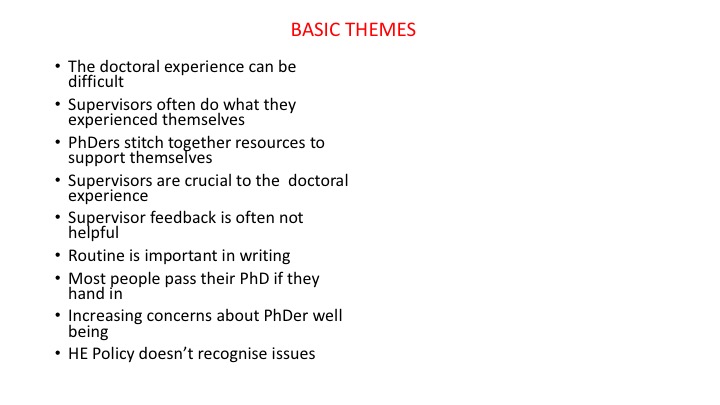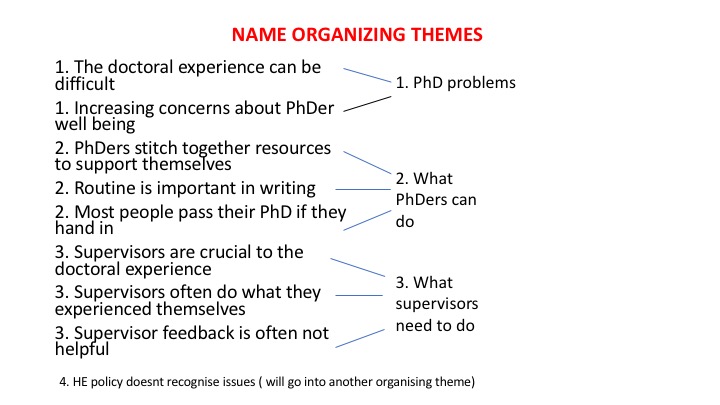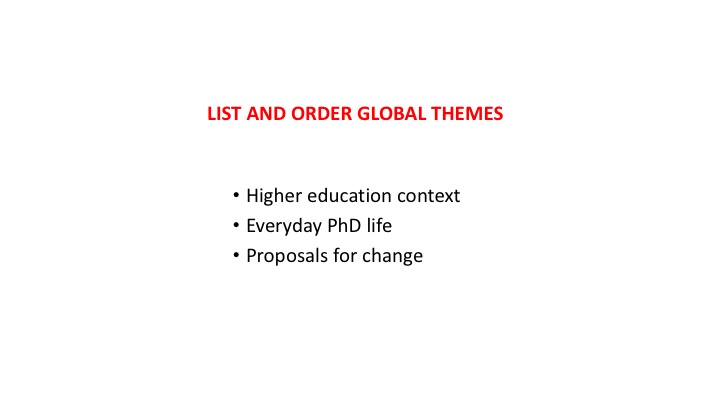If you are about to start reading for your doctorate, or are already in the reading phase, then you know that you are reading in order to:
- refine your research question,
- locate your work in the field,
- identify your potential contribution, and
- find material that helps you to plan your research and analysis.
You may already know how all that reading will end up – you may have a chapter in the final text that presents your literature work, or you’ll weave the reading throughout the proposal and final thesis text.
You’ll notice that I’ve said your work on the literatures/reading. What is that work? Well, in addition to closely reading some key texts which are key to your research, you also need to read more widely in order to identity the key themes that relate to your topic (to do the four tasks outlined above). Yes. Themes.
And what do you do with reading themes? Here’s one way to deal with the themes you derive from your reading.
You will most likely work with three levels of themes. These are:
Basic themes – these come directly from the literatures that you are reading
Organising themes – basic themes are clustered together, and they collectively form a higher order idea. You assign a label – or category – to each higher order theme, a.k.a. organising idea.
Global theme – this is an overarching Big Idea which encapsulates an overall grouping of important and complex ideas and themes.
Let me give you an idea of how these three theme levels look. Imagine you are studying the doctoral experience. You have read a lot of stuff – books, blogs, papers. You have identified a number of basic themes. Each of these themes has a number of texts attached to it.

Once you have your basic themes, you can order them and then decide what higher order ideas they represent – organising themes.


And then finally, you can establish a global theme which brings together the organising themes, each one with their own set of basic themes.

You are likely to create more than one global theme in your literature work and they will either go into different chapters OR they will together form a stand-alone literatures chapter.

Once you have this kind of thematic pattern making work done, you are ready to move on to turning your hierarchy of themes into an argument. That’s Part Two of this mini-series.










Thank you, Pat. As ever, this post is extraordinarily helpful, for my thinking about writing and my teaching. I hope that things are calm and manageable for you. warm good wishes, Colin
LikeLike
This was really useful, thanks so much for sharing!
LikeLike
I found this very helpful thank you. I am redrafting my literature review in the light of my findings and my sense of argument is very clear now. I feel like this is a Janus process – I can see my research interests being developed by the readings and the connections to my findings. My issue now is this – using your model to frame the argument how close do I get to indicating my findings in this chapter? Or is the big reveal just left to that chapter? I am going round in circles so any thoughts would be most helpful! Thank you
LikeLike
You don’t usually reveal the results in lit. You work with the literatures that you will use to locate the contribution, construct your research, inform your analysis. You’ve already talked about the overall argument in the intro and the trawl of chapters probably.
LikeLike
Thank you. I had looked at your posts on contribution and I’ve been reading about dinner tables and octopus and I see how to manage this by referencing contribution as the red thread! Thank you . This is a tough one to grapple with when your head is full of reading but your metaphors really make it concrete .
LikeLike